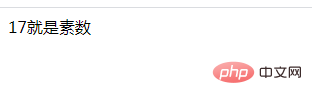
In the previous article "PHP Loop Learning Ten: Determine the Number of Narcissus and Print the Number of All Narcissus", we will introduce to you how to determine the number of narcissus and use a loop to output the number of all narcissus. Method, let’s continue learning about PHP loops and introduce how to determine whether a number is a prime number and output a prime number from 1 to 100. Interested friends can learn about it~
First of all, let’s learn about it What are prime numbers?
Prime number (prime number) refers to a natural number that cannot be divided by other numbers except 1 and itself; if it can be divided by other numbers, it is called a composite number (stipulation) 1 is neither prime nor composite).
For example: the numbers 2, 3, 17, and 19 are all prime numbers. They can only be divided by 1 and themselves.
So if a number num (for example, 17) is given, how do we determine whether this number num is a prime number? Here are several methods to introduce to you:
Method 1: The simplest method is to find based on the definition of prime numbers
Thinking:
Prime numbers can only be divisible by 1 and itself, that is, they can only be divided by 2 times.
So we use loops to divide N by using every natural number greater than 1 and less than or equal to N, and count the number of times it is divided. If the number is greater than 2, it is not a prime number; if it is equal to 2, then is a prime number.
Let’s take a look at the implementation code:
<?php
header("content-type:text/html;charset=utf-8");
$num=17;
$count = 1;
for($i = 2; $i <= $num; $i++) {
if(($num % $i)== 0)
$count ++;
}
if($count == 2) {
echo $num . '就是素数<br/>';
}else{
echo $num . '不是素数<br/>';
}
?>Output result:

## Method 2:
Idea: Use a number to divide 2 tosqrt (this number) respectively. If it can be divided evenly, it means that the number is not a prime number, otherwise it is a prime number.
<?php
header("content-type:text/html;charset=utf-8");
$num=19;
$flag = 1;
for($i = 2; $i*$i <= $num; $i++) //能被2 - sqrt(i)整除的数
{
if($num % $i == 0)
{
$flag = 0;
break;
}
}
if($flag == 1) {
echo $num . '就是素数<br/>';
}else{
echo $num . '不是素数<br/>';
}
?>
How to give a range (such as 1~100) and output all prime numbers?
Do you want to use two loops? Based on the above for loop, just put a layer of for loop outside to control the range. Let’s take a look at the implementation code (directly using the code of method 2):<?php
header("content-type:text/html;charset=utf-8");
$count = 0;
for($k = 2; $k <= 100; $k++){ //从2开始,遍历到100
$flag = 1;
for($i = 2; $i*$i <= $k; $i++) {//能被2 - sqrt(i)整除的数
if($k % $i == 0)
{
$flag = 0;
break;
}
}
if($flag == 1) {
echo $k . '是素数<br/>';
$count ++;
}
}
echo '<br/>1~100间共有 '.$count." 个素数";
?>
$count is used. After each prime number is output, it increases by 1, so that we can count how many prime numbers there are between 1 and 100.
Recommended: 《PHP interview questions summary (collection)》
The above is the detailed content of PHP Loop Learning 11: How to determine prime numbers, print prime numbers from 1 to 100, and count their numbers. For more information, please follow other related articles on the PHP Chinese website!




